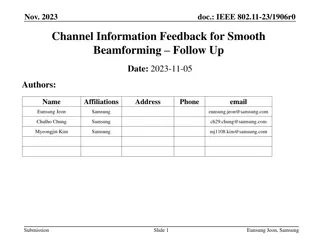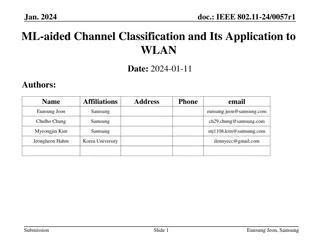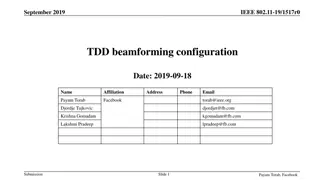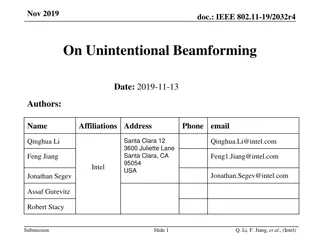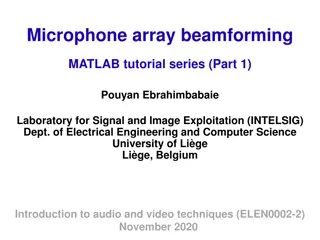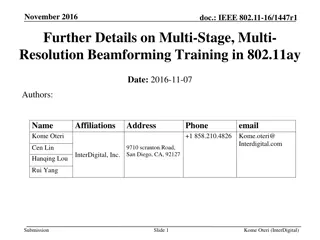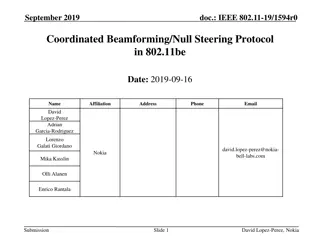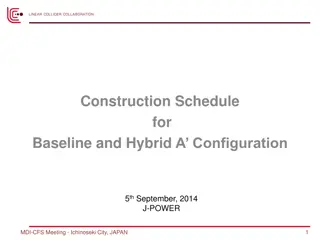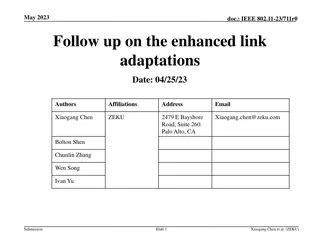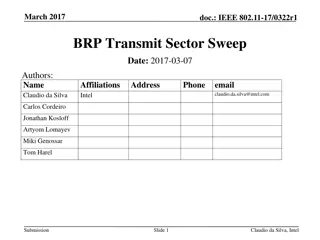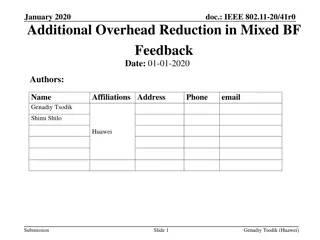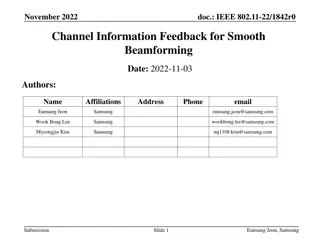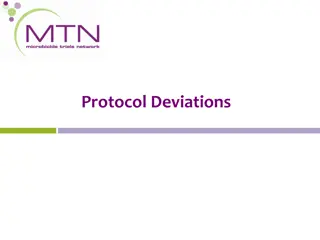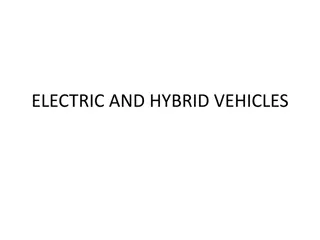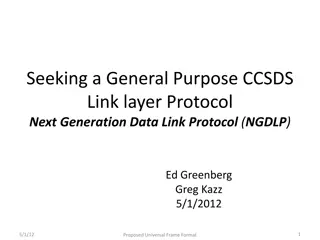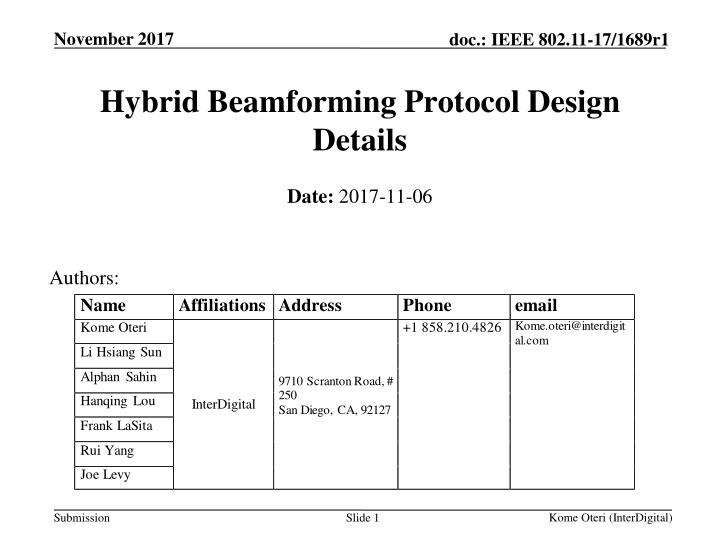
IEEE 802.11-17/1689r1 Hybrid Beamforming Protocol Design Details
Explore the details of the Hybrid Beamforming Protocol design discussed in the November 2017 documentation for IEEE 802.11-17/1689r1. The protocol supports digital baseband training, hybrid precoding, and includes phases like Announcement, Sounding, and Feedback. Learn about the phases and concepts involved in this innovative protocol for efficient MIMO setups.
Download Presentation

Please find below an Image/Link to download the presentation.
The content on the website is provided AS IS for your information and personal use only. It may not be sold, licensed, or shared on other websites without obtaining consent from the author. If you encounter any issues during the download, it is possible that the publisher has removed the file from their server.
You are allowed to download the files provided on this website for personal or commercial use, subject to the condition that they are used lawfully. All files are the property of their respective owners.
The content on the website is provided AS IS for your information and personal use only. It may not be sold, licensed, or shared on other websites without obtaining consent from the author.
E N D
Presentation Transcript
November 2017 doc.: IEEE 802.11-17/1689r1 Hybrid Beamforming Protocol Design Details Date: 2017-11-06 Authors: Name Kome Oteri Affiliations Address Phone +1 858.210.4826 Kome.oteri@interdigit email al.com Li Hsiang Sun Alphan Sahin 9710 Scranton Road, # 250 San Diego, CA, 92127 Hanqing Lou InterDigital Frank LaSita Rui Yang Joe Levy Kome Oteri (InterDigital) Submission Slide 1
November 2017 doc.: IEEE 802.11-17/1689r1 Introduction TGay has agreed that 11ay will support hybrid precoding for SU-MIMO and MU-MIMO [1] Performance of hybrid precoding with the transmission and reception of EDMG Single Carrier Mode PPDUs has been shown in [2], and [3], and on EMDG OFDM PPDUs in [4]. The results show gains of hybrid precoding over analog precoding in certain scenarios e.g. antenna configuration, transmit power. A framework for the HBF protocol was agreed to in [4]. In this contribution, we discuss in further detail the difference phases of the HBF protocol. Details on associated signaling will be presented in a subsequent contribution. Kome Oteri (InterDigital) Submission Slide 2
November 2017 doc.: IEEE 802.11-17/1689r1 HBF Protocol Supports digital baseband training and hybrid precoding information feedback for subsequent Hybrid Precoding transmission Performed after MIMO BF setup is completed for both SU- MIMO and MU-MIMO (based on straw poll results). Requires sounding and feedback to acquire the HBF information. Conceptual HBF Protocol Kome Oteri (InterDigital) Submission Slide 3
November 2017 doc.: IEEE 802.11-17/1689r1 HBF Protocol Details The Hybrid Beamforming Protocol comprises the following phases Announcement Phase (Optional) Sounding Phase Feedback Phase On completion of the HBF protocol, HBF transmission can take place Sounding (BRP) HBF Transmission Announcement Announcement ACK Feedback HBF Protocol for Initiator Only HBF protocol Kome Oteri (InterDigital) Submission Slide 4
November 2017 doc.: IEEE 802.11-17/1689r1 Announcement Phase Announcement phase indicates desire to start HBF protocol Similar to NDPA in 802.11n/ac [5] Used to set up the STAs and the antenna configurations of the selected STAs in the SU/MU-MIMO hybrid beamforming transmission. The announcement frame transmitter/receiver are already set in the required configuration. The feedback parameters are sent during the sounding phase using existing signaling. is optional if the Kome Oteri (InterDigital) Submission Slide 5
November 2017 doc.: IEEE 802.11-17/1689r1 Announcement Phase Proposal Utilize the SU-MIMO/MU-MIMO channel access procedure (10.36.11.4.3,[1]) Transmitting STA sends grant frame (or RTS) with a control trailer (CT) to a peer EDMG STA to indicate intent to transmit a MIMO PPDU to the peer STA. The transmitted grant frame GRANT_RTS_CTS2SELF CT indicates antenna configuration of upcoming SU-MIMO transmission Recipient STA sends Grant ACK (or CTS) to transmitting STA if it is able to perform SU-MIMO reception and configures antennas to requested configuration. If it desires a reverse SU-MIMO transmission, it may include a CT with the required reverse configuration. Parameters indicated in CT [1] Type: SISO/MIMO; SU/MU-MIMO; Antenna Configuration : {SU-MIMO} Tx Sector Combination Index, {MU- MIMO} EMDG Group ID MU-MIMO Transmission Configuration, MU- MIMO Transmission Configuration Index sets CT to CT_TYPE: Kome Oteri (InterDigital) Submission Slide 6
November 2017 doc.: IEEE 802.11-17/1689r1 SU MIMO Channel Access [1] Change from data transmission to HBF Protocol SU-MIMO channel access procedure Kome Oteri (InterDigital) Submission Slide 7
November 2017 doc.: IEEE 802.11-17/1689r1 MU MIMO Channel Access [11] RTS CT CT RTS MU-MIMO Initiator CT RTS SIFS MU PPDU transmission and receiving DMG CTS MU-MIMO Responder 1 DMG CTS MU-MIMO Responder 2 DMG CTS MU-MIMO Responder 3 SIFS MU-MIMO antenna setting SISO CT: Control Trailer antenna setting Change from data transmission to HBF Protocol Kome Oteri (InterDigital) Submission Slide 8
November 2017 doc.: IEEE 802.11-17/1689r1 Sounding Phase Sounding Phase enables measurement of the baseband channel Uses the TRN subfields to sound the channel. Can be implemented with multiple methods within current 11ay framework: BRP frame exchange: The BRP request may use the TRN field dimensions suitable for the antenna configuration in the announcement i.e. EDMG TRN Length field, P, M , N Beam Tracking procedure: DMG Header and EDMG Header-A are used to set up the TRN field dimensions for the antenna configuration in the Announcement. Operation: Use BRP on initial HBF protocol setup. Use BRP in scenarios where configuration is fixed but feedback changes. Use Digital Beam Tracking in scenarios where configuration and feedback needed do not change. Kome Oteri (InterDigital) Submission Slide 9
November 2017 doc.: IEEE 802.11-17/1689r1 Feedback Phase Feeds back HBF information needed by transmitter for HBF transmission. The hybrid Beamforming information differs for SC vs OFDM PPDUs EDMG SC Mode: Time domain information: Beam Steering Matrices Channel Measurement Matrices OFDM PPDU : Frequency domain information Beam Steering Matrices only May be incorporated within a MIMO feedback frame [6] Signaling for Feedback incorporated in Sounding Frames Kome Oteri (InterDigital) Submission Slide 10
November 2017 doc.: IEEE 802.11-17/1689r1 HBF Transmission On completion of the HBF protocol, the HBF transmission may take place. For EDMG SU PPDUs to which HBF is applied, Q_(Bt,i) is a digital beamforming steering matrix and is derived from the TXVECTOR parameter EXPANSION_MAT. For EMDG MU PPDUs to which HBF is applied, Q_(Bt,i) is a digital beamforming steering matrix and is derived from the TXVECTOR parameter EXPANSION_MAT. The digital beamforming steering matrices and digital DL-MU-MIMO steering matrices are implementation specific. Kome Oteri (InterDigital) Submission Slide 11
November 2017 doc.: IEEE 802.11-17/1689r1 Signaling Announcement: Use existing CT signaling Sounding: Use existing BRP and tracking procedures Feedback: Add signaling for FB request/response parameters SC Request: Digital Beamforming Request, HBF Information Feedback Type (Request) SC response: HBF Information Feedback Type (Response) OFDM Request: Number of streams, SU/MU OFDM Response: OFDM feedback parameters Accepted, not defined Kome Oteri (InterDigital) Submission Slide 12
November 2017 doc.: IEEE 802.11-17/1689r1 Conclusion In this contribution, we have discussed the details of the HBF protocol design and its associated phases: Announcement phase: Use SU/MU MIMO channel access procedure Sounding phase: use TRN based sounding with BRP or Digital Baseband Tracking Feedback phase: EDMG SC Mode: Time domain beam steering feedback or channel measurement feedback. EDMG OFDM Mode: Frequency domain beam steering feedback. Kome Oteri (InterDigital) Submission Slide 13
November 2017 doc.: IEEE 802.11-17/1689r1 References 1. 2. IEEE P802.11ay /D0.8 L. Sun, et al, Link Level Performance Comparisons of Open Loop, Closed Loop and Antenna Selection for SU-MIMO 11-16/0911r1 K. Oteri et al, Closed Loop SU-MIMO Performance with Quantized Feedback 11- 16/1446r0 . K. Oteri, et, al, Hybrid Beamforming for SC and OFDM Transmission in 11ay 11- 17/1533r1 IEEE 802.11-2016 3. 4. 5. Kome Oteri (InterDigital) Submission Slide 14
November 2017 doc.: IEEE 802.11-17/1689r1 Straw Poll Do you agree to the following: Include the text proposed in 17/1692r1 for the definition of Hybrid Beamforming Protocol Design Details into the IEEE 802.11ay draft amendment ? Y/N/A Kome Oteri (InterDigital) Submission Slide 15

